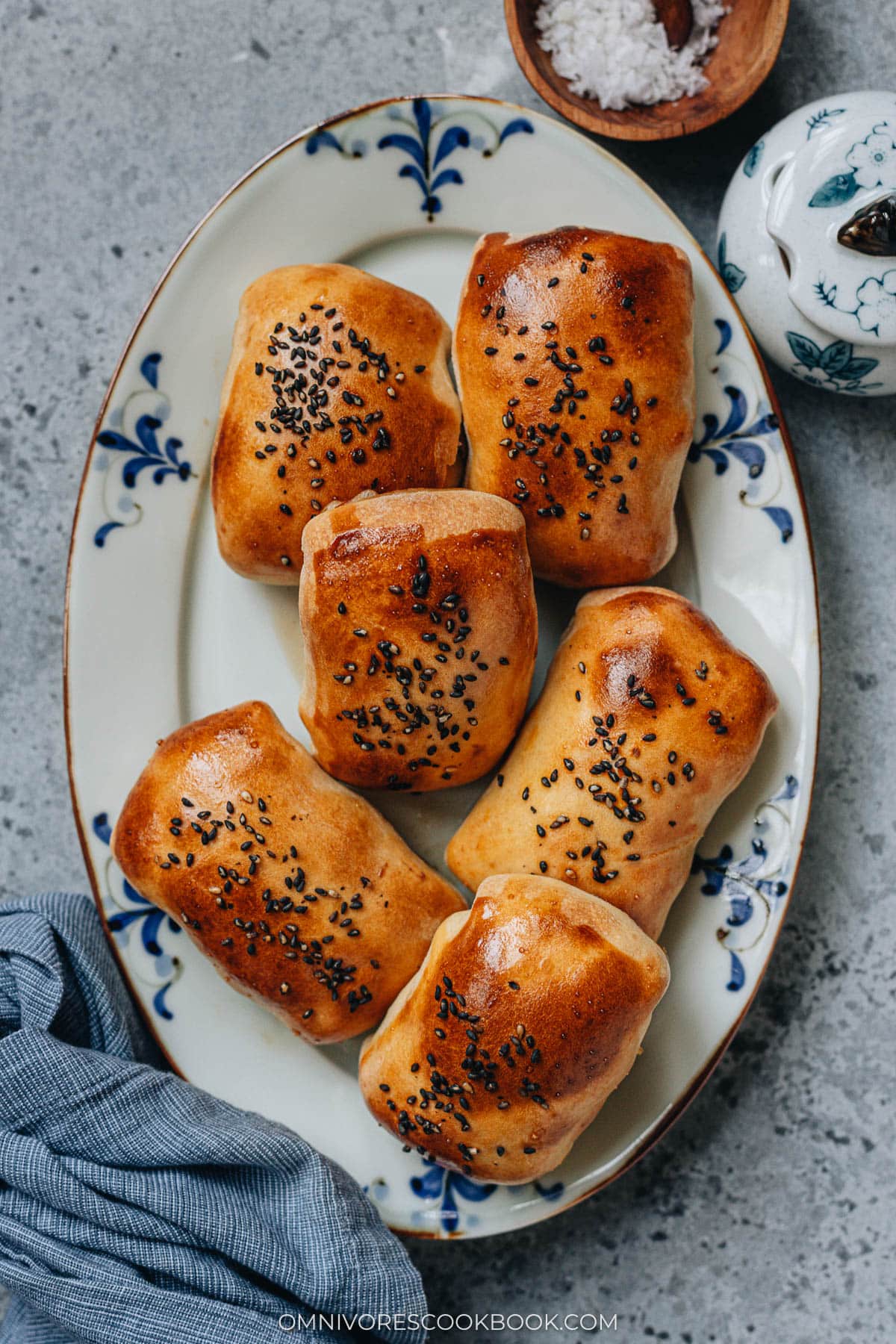
What is Kao Bao Zi?
Kao Bao Zi (烤包子), literally translated as “baked buns” and known in Uyghur as Samsa, is one of the most significant dishes from Xinjiang cuisine. Just like Xinjiang lamb skewers and Xinjiang Laghman, this recipe also uses the regional staple lamb as the main ingredient.
Growing up in Beijing, Kao Bao Zi was one of my favorite snacks to order from the restaurant. Unlike the more common steamed baozi, these buns do not use a yeast dough, and are baked until the dough becomes golden brown and slightly chewy. The aromatic spices reflect the influence of Silk Road cuisine, where Central Asian flavors mingle with Chinese techniques.
If you love dumplings and bao but want something with more texture and a toasty aroma, Kao Bao Zi is worth adding to your repertoire and why not as part of your Asian Thanksgiving recipes.
Ingredients
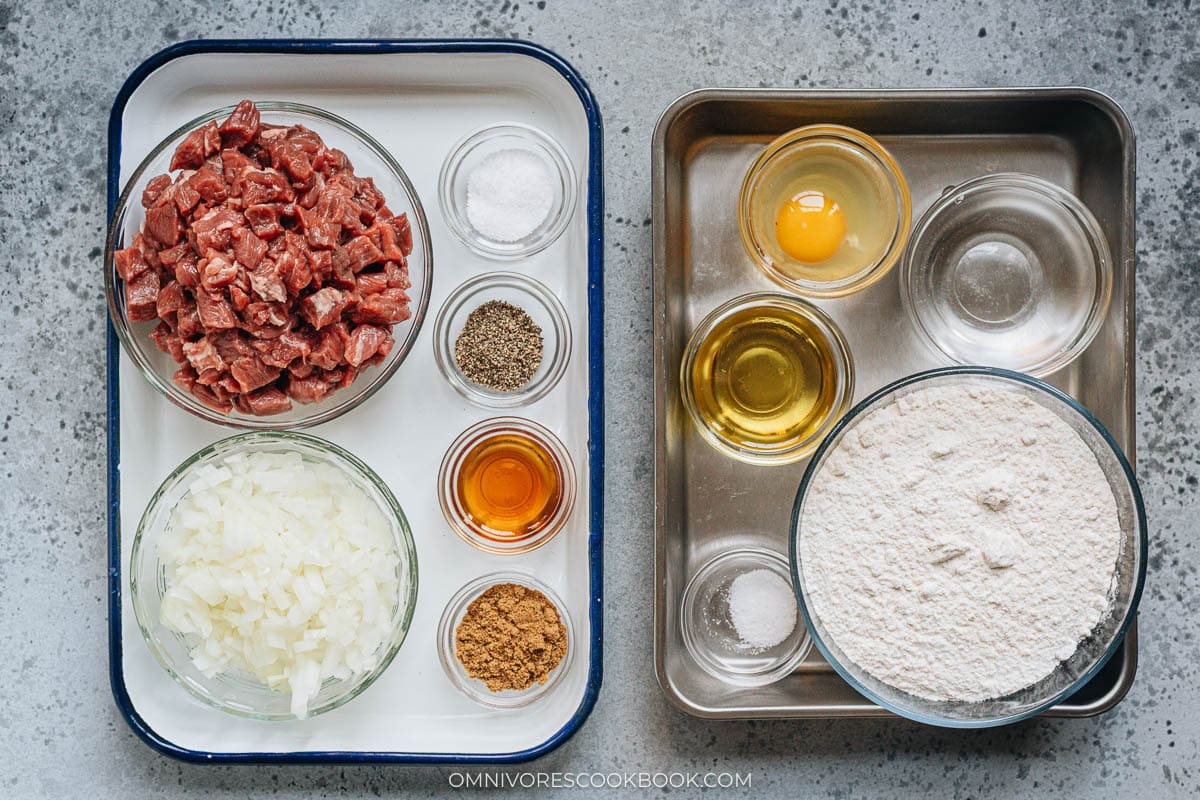
Kao Bao Zi requires pretty simple ingredients to make.
The dough is made with all-purpose flour, oil, egg and a bit of water. The oil and egg make the buns tender, rich, and flavorful.
The filling uses lamb meat and onion, with a few simple ingredients. The main flavor element is cumin powder, which is commonly used in Xinjiang cuisine.
What cut of lamb to use
Lamb leg is my favorite cut to use in Kao Bao Zi. It is rich and flavorful, with a good ratio of lean to fat. Alternatively, you can also use stew meat instead. If the cut you use is quite fatty, do not trim off all the fat! In fact, it’s more delicious if you add small bits of fat into the filling, which make the buns juicier once baked.
To make authentic Kao Bao Zi, you should always use lamb meat diced into small pieces for texture. However, it is OK to replace it with ground lamb as well. The buns will have a different texture but will be delicious regardless.
Different filling variations
Although lamb is the default filling for Kao Bao Zi, it’s totally OK to use a different meat.
My top alternative is beef. A marbled cut such as flank and skirt are great options. Beef has a strong flavor that works beautifully with cumin. It’s always a great alternative to lamb.
Another option is chicken thigh. Because chicken thighs are fattier than breast and have more flavor, they work better in this recipe than breast.
It is possible to use pork as well, but you want to make sure the pork you use is not too lean, which would give you a dry and chewy filling.
Kao Bao Zi usually uses onion to accompany the meat. You can also add a very small amount of finely diced carrot for color.
How to make
Prepare the filling
Make the filling first and let marinate in the fridge, so the lamb will be more flavorful. Again, if possible, make sure to mix in a small amount of lamb fat. A great way to add flavor without making the Kao Bao Zi greasy is to trim off some fat, then cut it into very small pieces (much smaller than the lean meat part). This way, the fat will melt into the buns during baking.
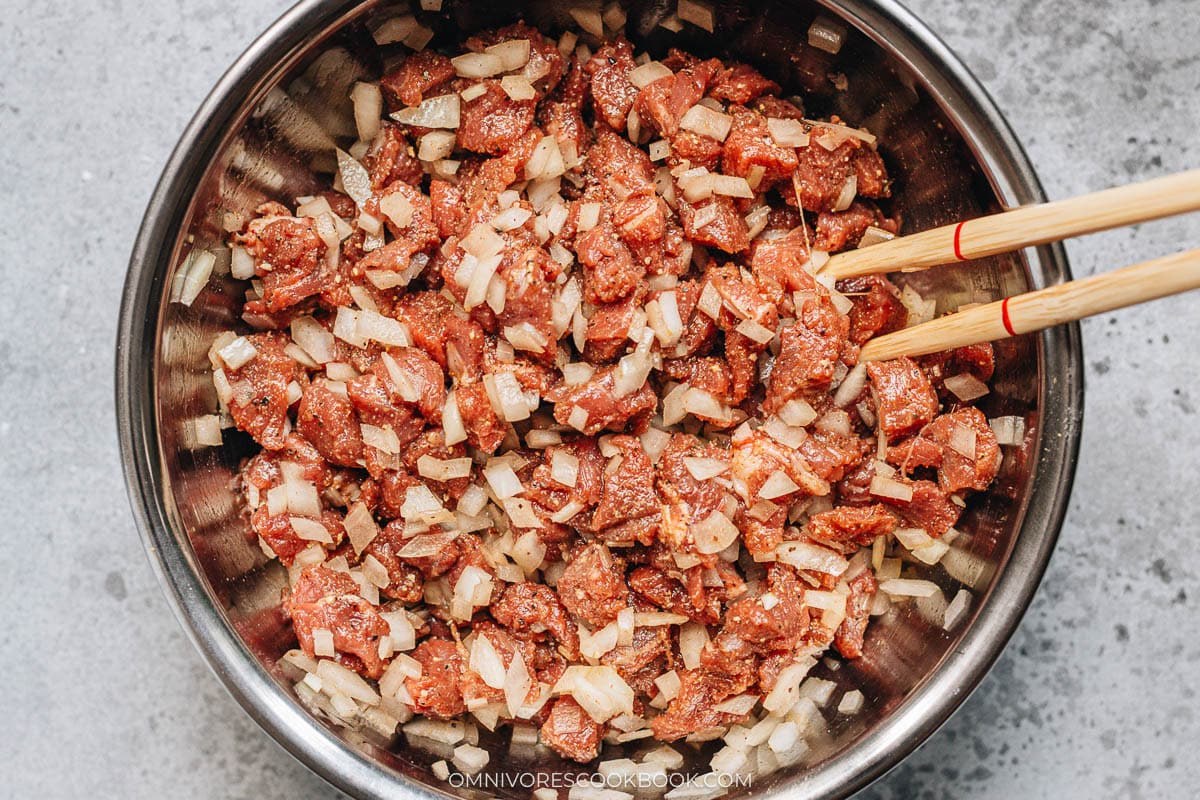
Prepare the dough
- Mix the flour with eggs and oil. Then slowly add warm water while mixing, until the water is fully incorporated. When adding water, make sure to mix it very slowly and onto the dried flour directly, to help with even mixing. Once all the ingredients are mixed, it should form soft dough flakes that are a little tacky but do not stick to your hands. There should be no / little dry flour left in the bowl. You might need to add more flour or water depending on the dough flake texture.
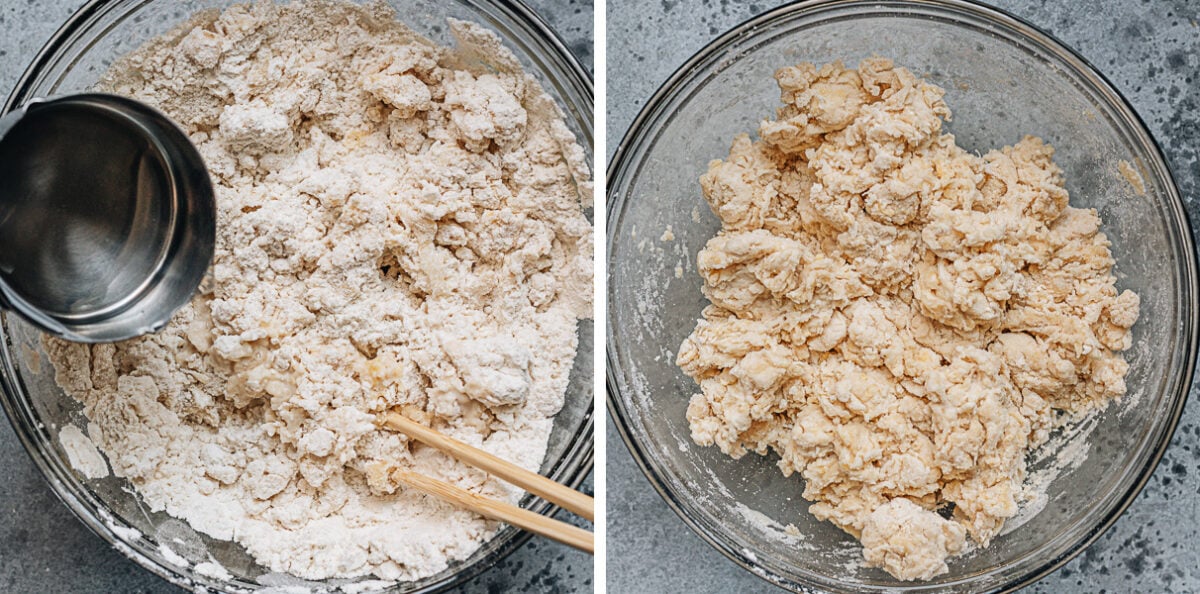
- 1st kneading: Then knead the dough for 5 to 10 minutes. The dough should be quite easy to work with and not stick much. After the first kneading, the dough is somewhat smooth but not super smooth. This is totally OK. It will become smoother after the second kneading.
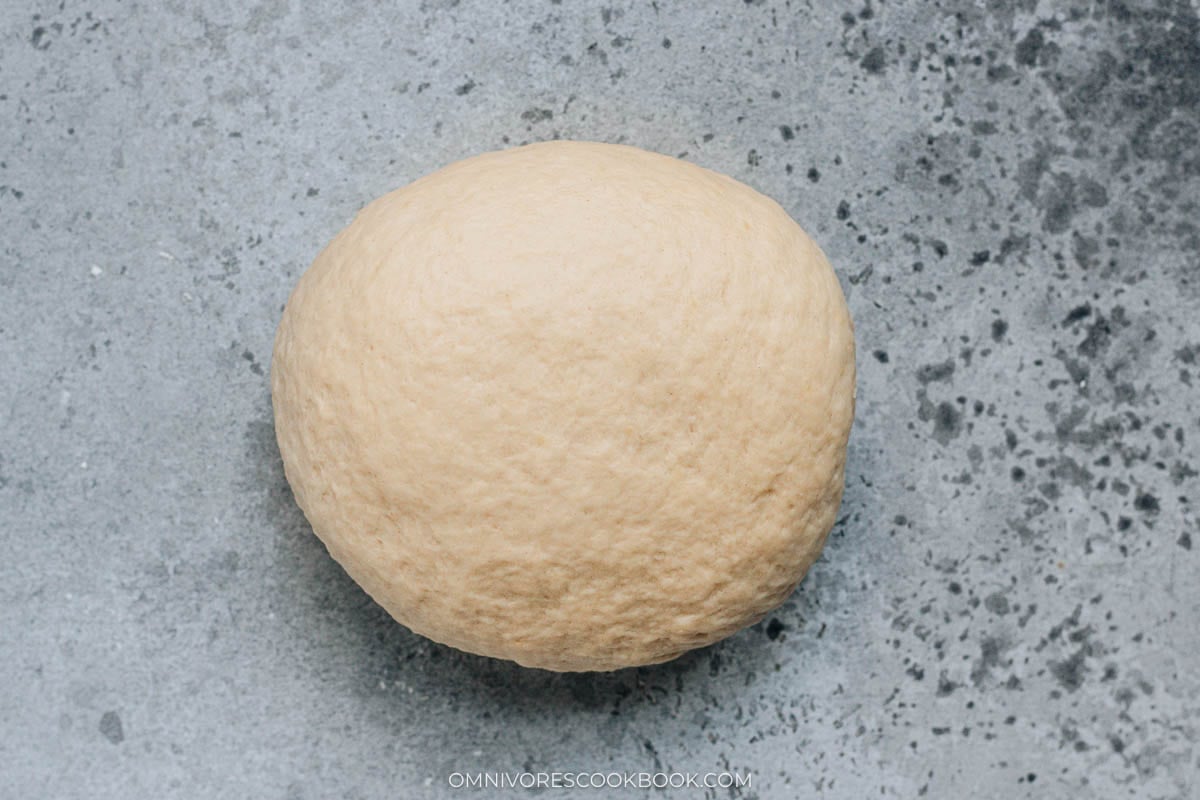
- 2nd kneading: After 15 minutes of resting, knead the dough a second time. This time you literally only knead the dough a few times and it will become very smooth. The first resting helps the dough hydrate evenly, so it’s very easy to knead the second time. After the 2nd kneading, let the dough rest for another 30 minutes to relax the gluten. So the dough becomes easy to work with when shaping the buns.
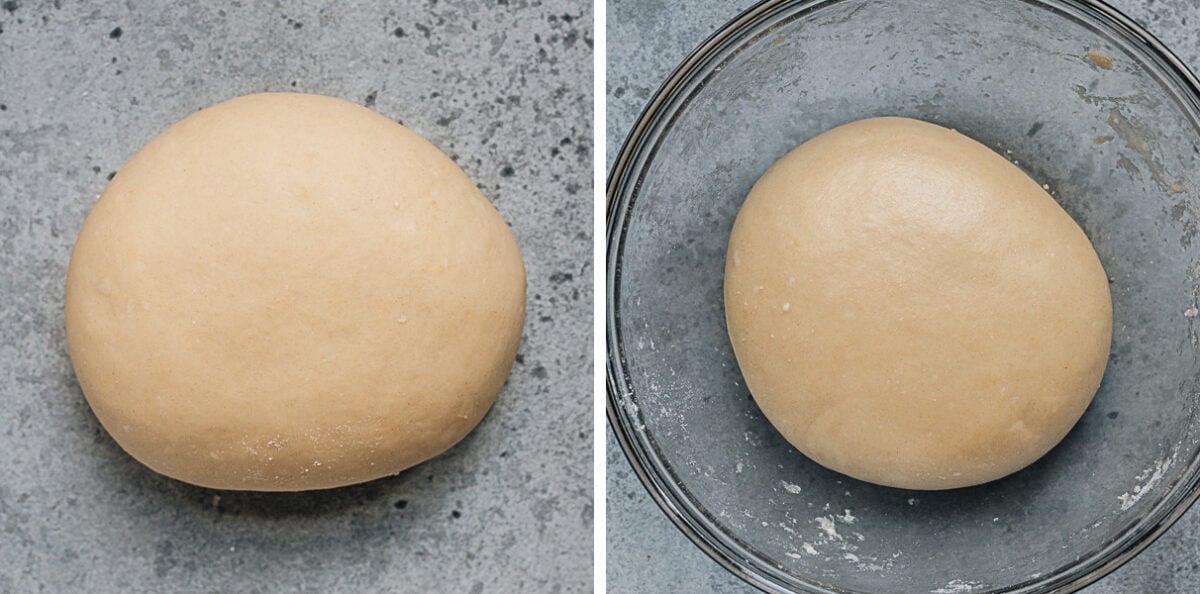
Shape the buns
- After resting the 2nd time, divide the dough into 10 even pieces by slicing the dough in half, then divide each half into 5 pieces. I usually like to weigh the dough (mine was 48 to 50 g per dough) to make sure they are similar in size. But you can skip the measuring as well, since it doesn’t affect the baking much. Make sure to always cover the dough you’re not working on, to prevent it from drying out.
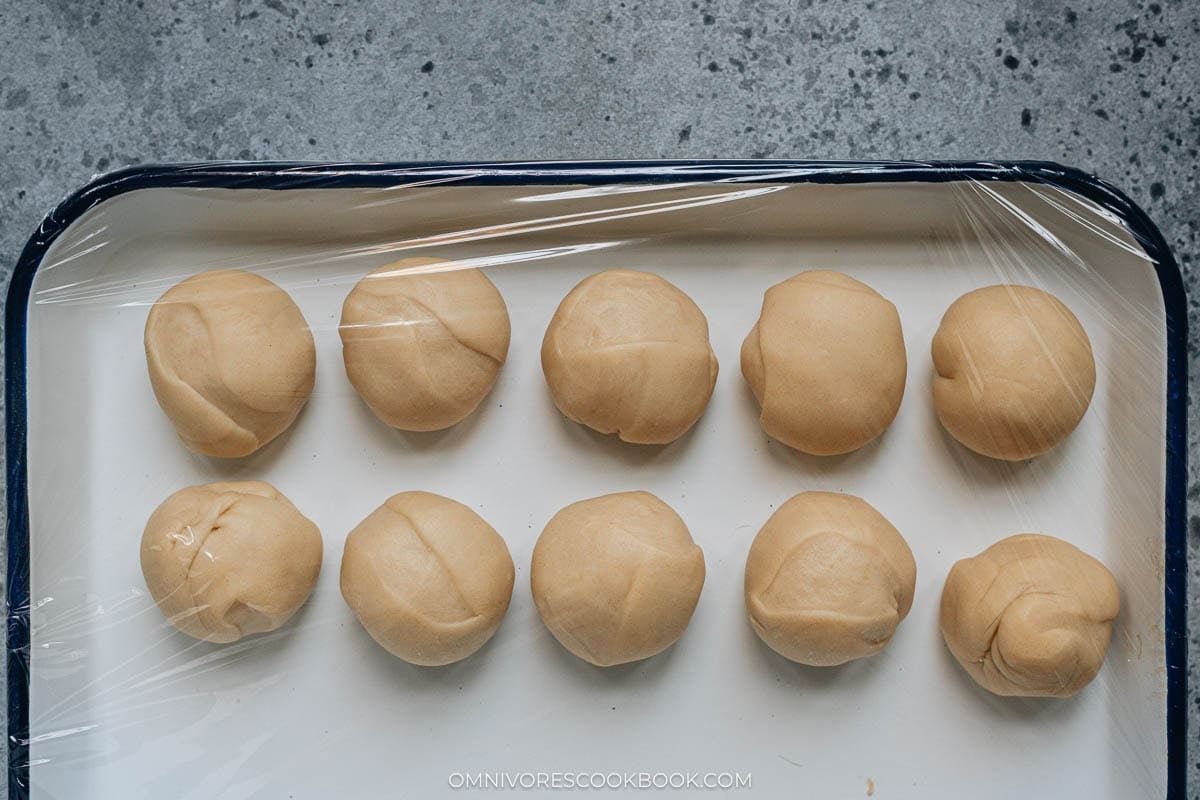
- Roll each dough piece into an oval shaped sheet. It should be thicker in the center and thin on the edges, so the folded buns will have a more even thickness.
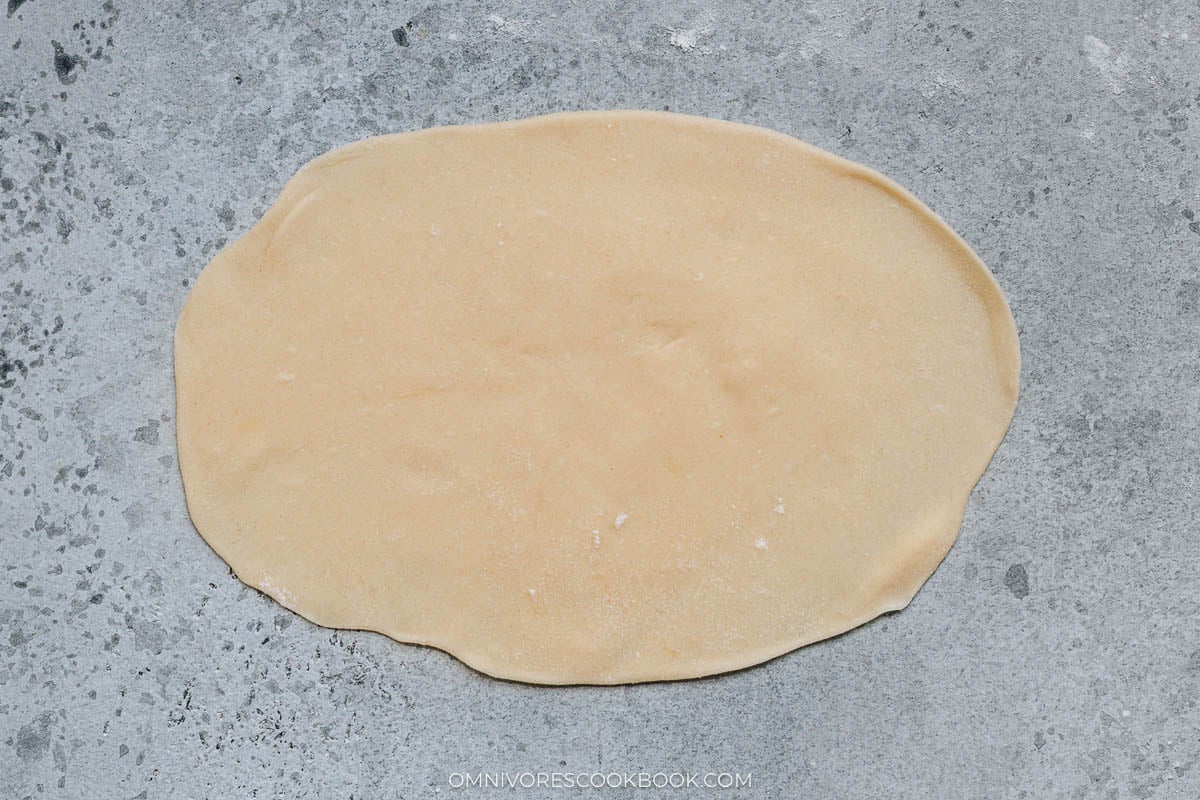
- Add about 4 tablespoons of filling into the center. I like to pack in as much filling as I can, to make the buns very rich and flavorful. Since we’re using freshly made dough, it’s quite elastic and can be stretched a bit during folding, which allows you to stuff in more filling.
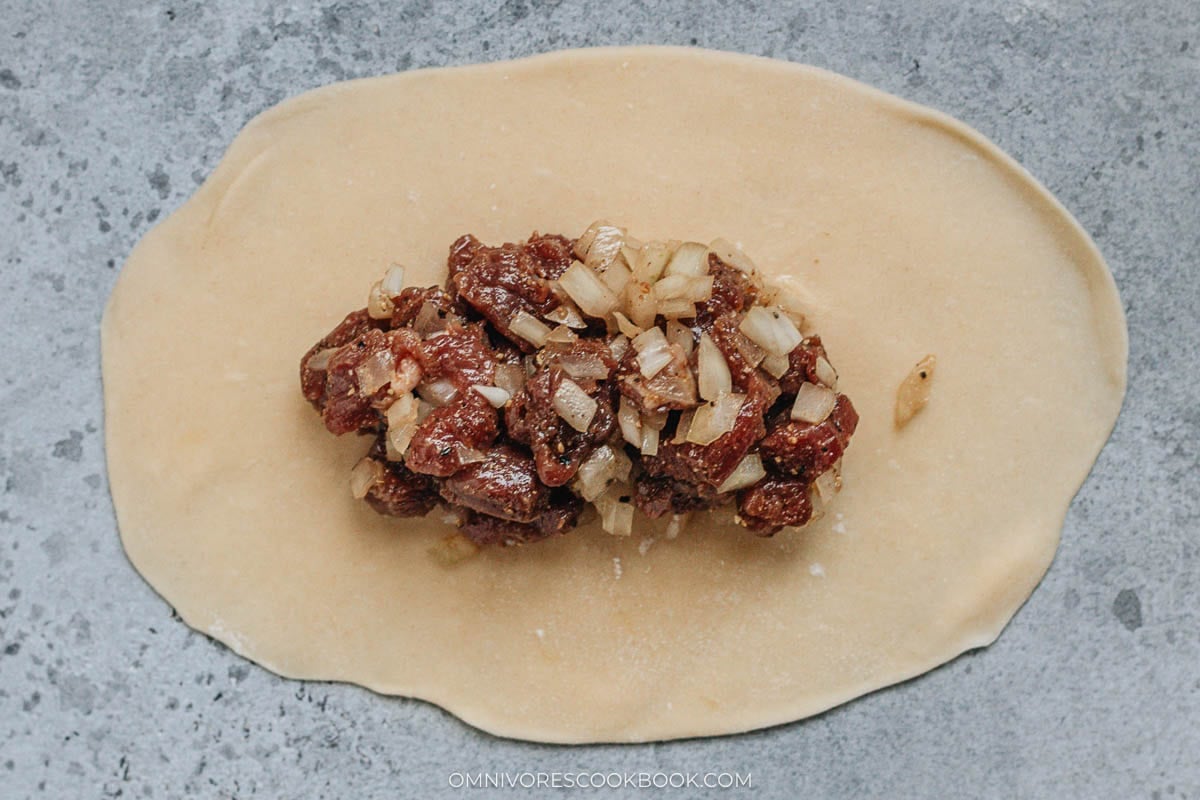
- Fold the long edges first. They should barely overlap. Pinch the edges together to seal.
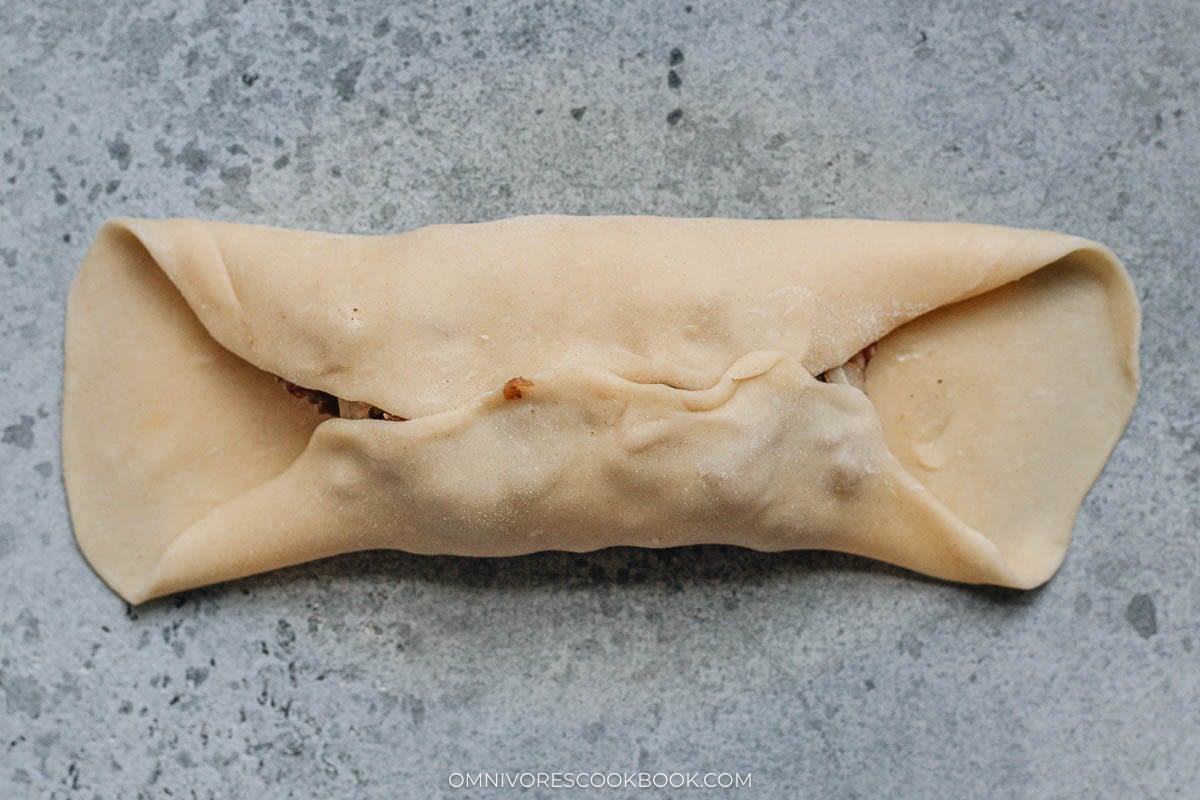
- Then fold the two short sides to the center. Again, make sure to pinch the edges to seal well. The bottom of the buns will always be thicker than the top, due to the multiple layers. That is why you want to roll the wrapper a little thin on the edges, so the bottom of the bun is not too thick.
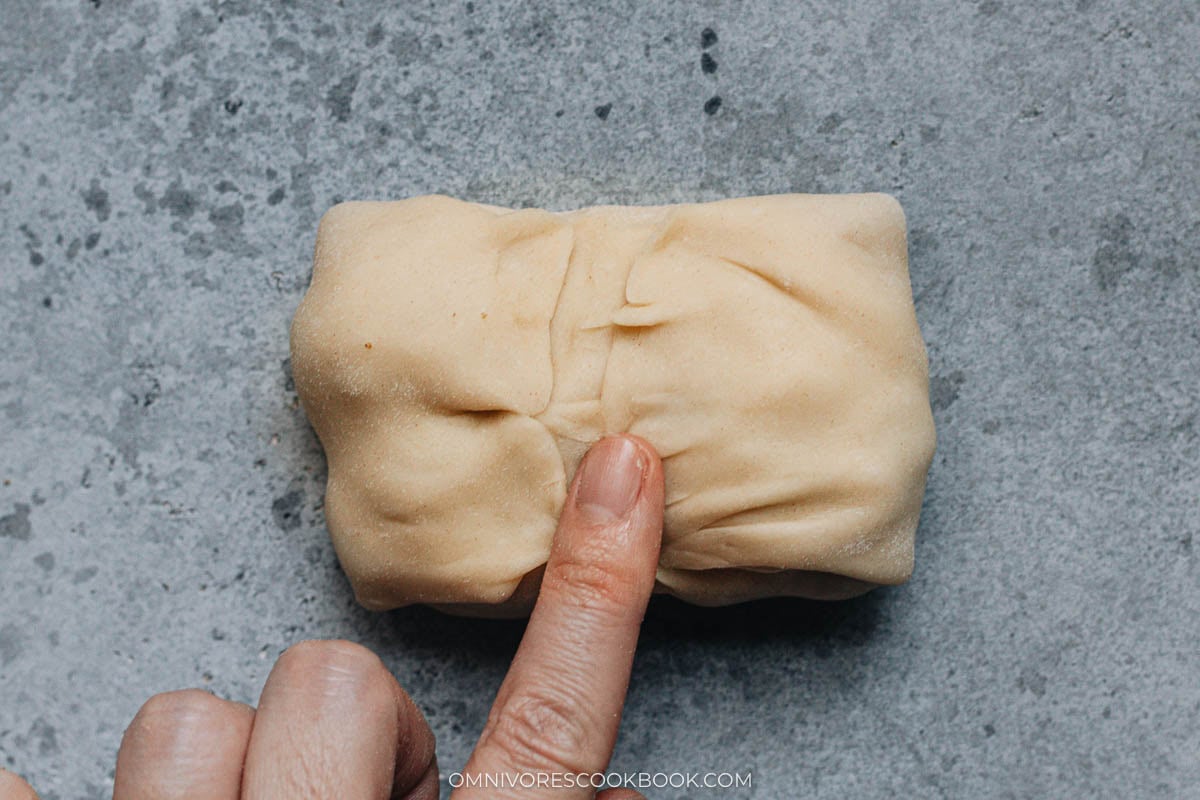
- Brush the buns with egg wash. Here I like to brush a generous amount of wash so the buns come out with a beautiful color.
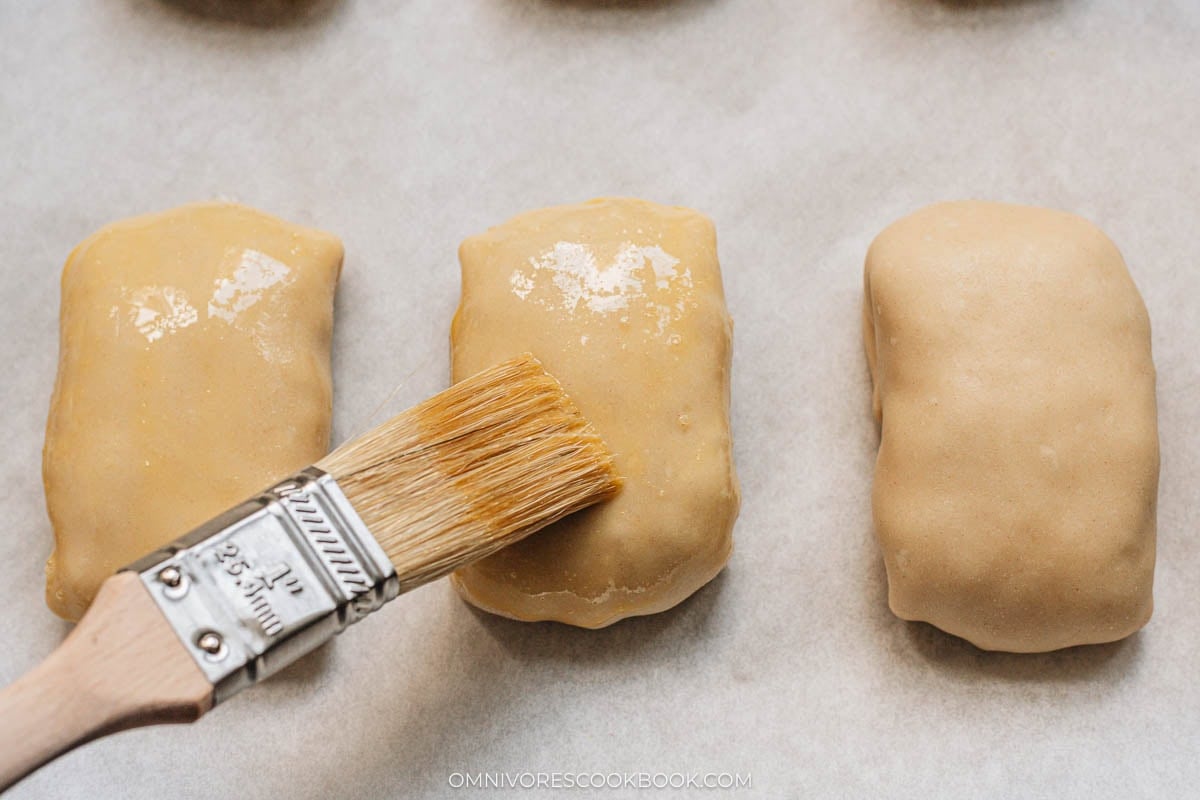
- Sprinkle sesame seeds onto the buns. Then bake them in the oven for 25 minutes.
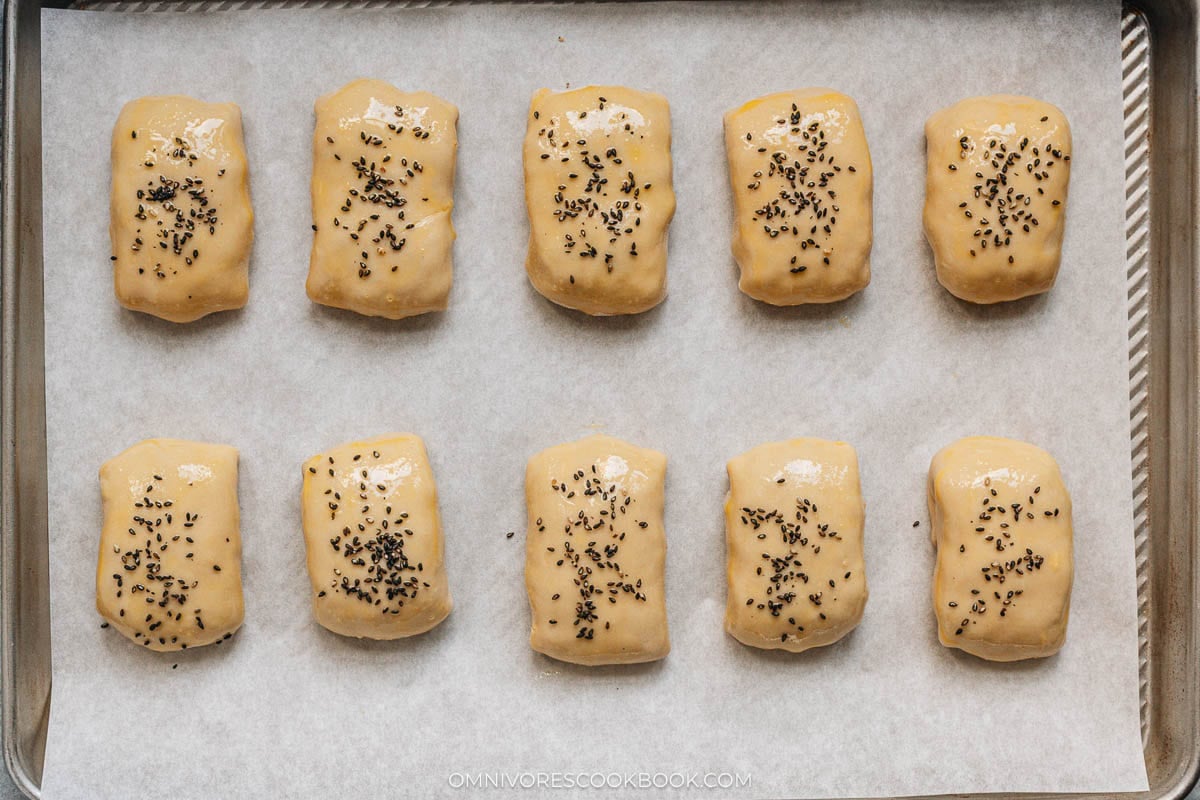
- Once baked, the buns should be golden brown and slightly inflated. Some juice from the filling will leak out, which is totally normal. Since we use a few layers of dough on the bottom, it protects the buns from falling apart. The thicker part of the dough also soaks up the lamb juice, making it extra delicious.
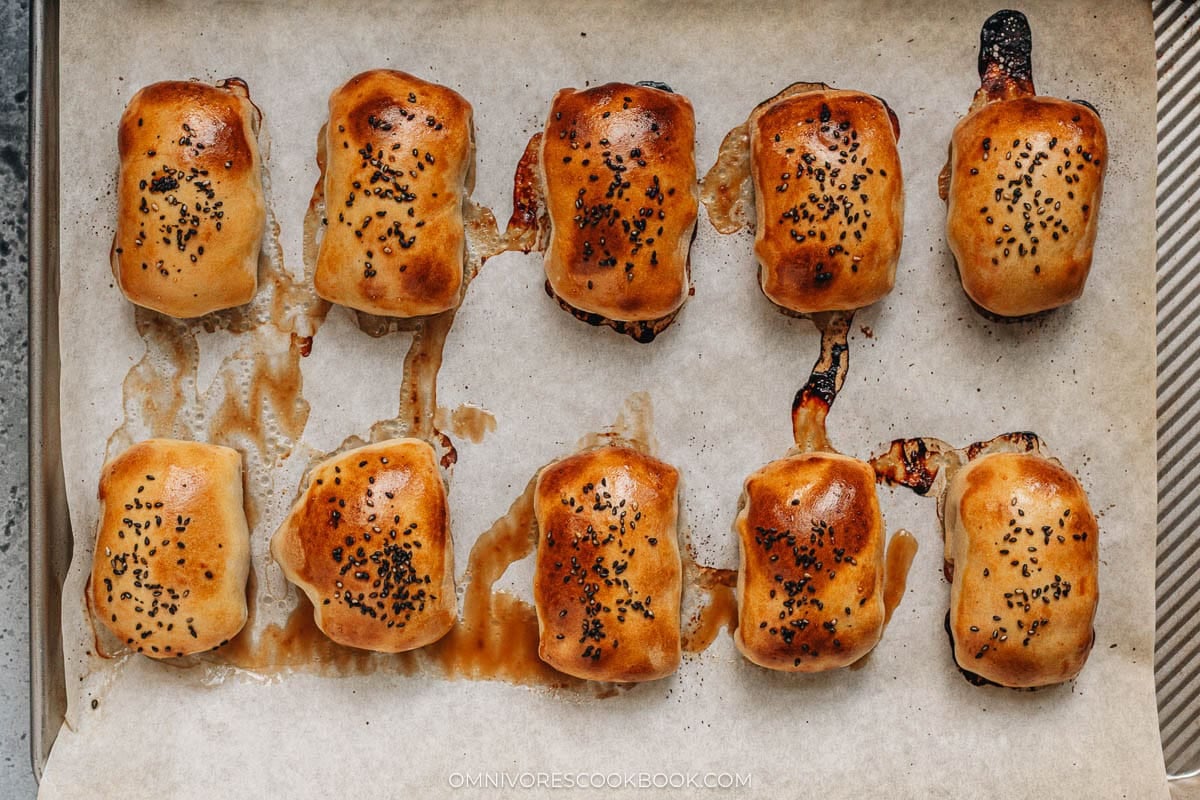
How to serve & reheat
Wait until the lamb buns cool off a little before serving them. If you cut one open, you will see that the top of the buns are inflated with some air pockets underneath. The outer layer is crispy and the inside a little chewy.
In China, we usually eat the buns by themselves because they’re fully seasoned and quite flavorful. But I’ve seen some Xinjiang restaurants in the US serve them with a tomato based sauce that is similar to salsa. If you prefer to serve these buns with a sauce, a simple salsa is a great option.
These buns make a great appetizer or a snack. They keep well in the fridge and freezer. If you freeze the buns, thaw them in the fridge before reheating. To reheat, simply heat them in the oven at 400°F (200°C) until warmed through, 10 minutes or so.
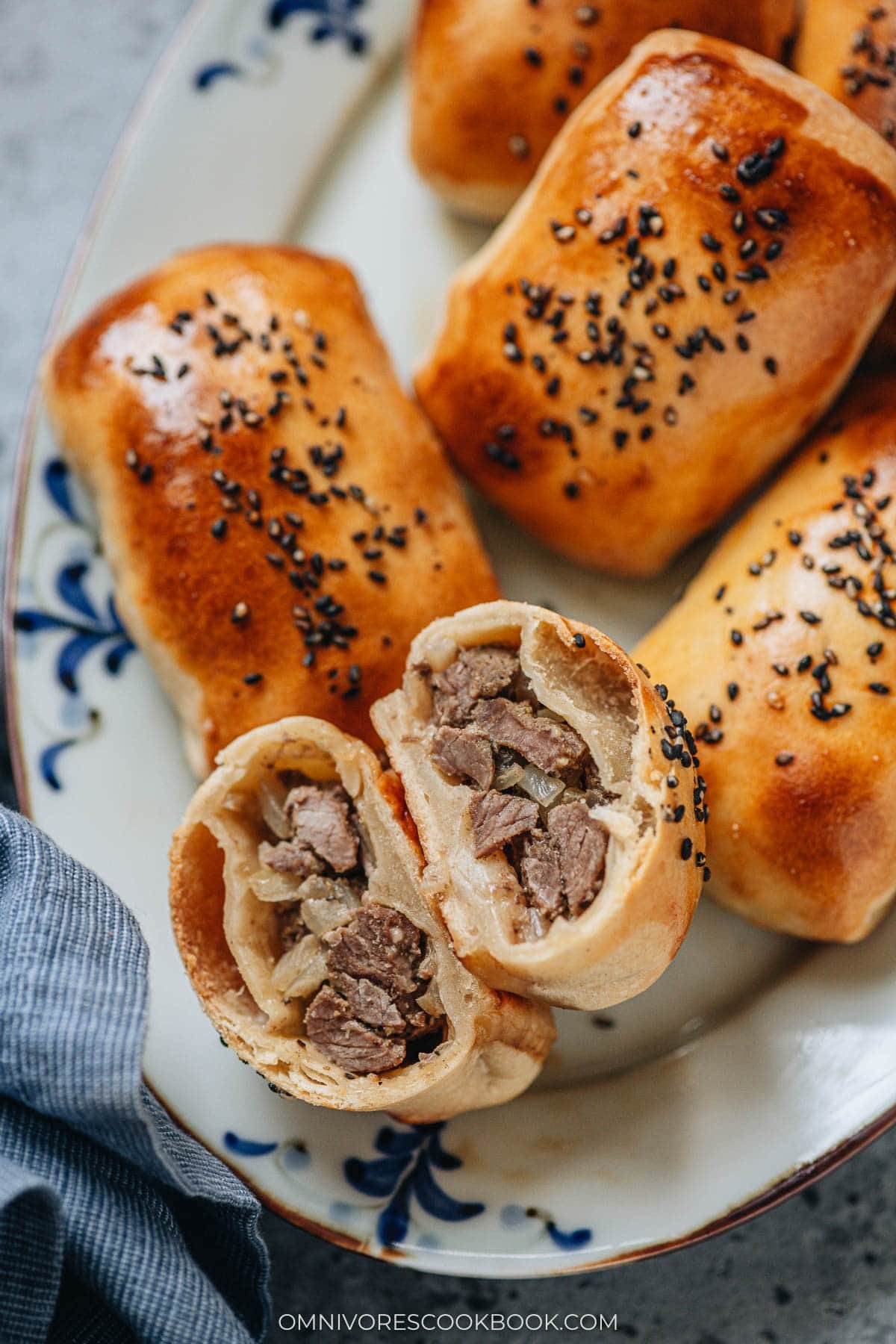
Frequently asked questions
How do I prevent the filling from leaking during baking?
Make sure to seal the buns tightly by pinching the dough firmly during folding. Rolling the dough a little thicker helps too. That being said, it’s totally normal if some lamb juice leaks out.
Can I prepare the dough or filling in advance?
Yes. The filling can be made a day ahead and refrigerated. The dough can also be prepared in advance and left to rest in the fridge overnight for a deeper flavor.
Can I freeze the buns and bake them from frozen?
Yes! Once you assemble the buns, you can place them in a large sealed container and freeze them. Bake the frozen buns directly without thawing. You might need to bake them a little longer in this case.
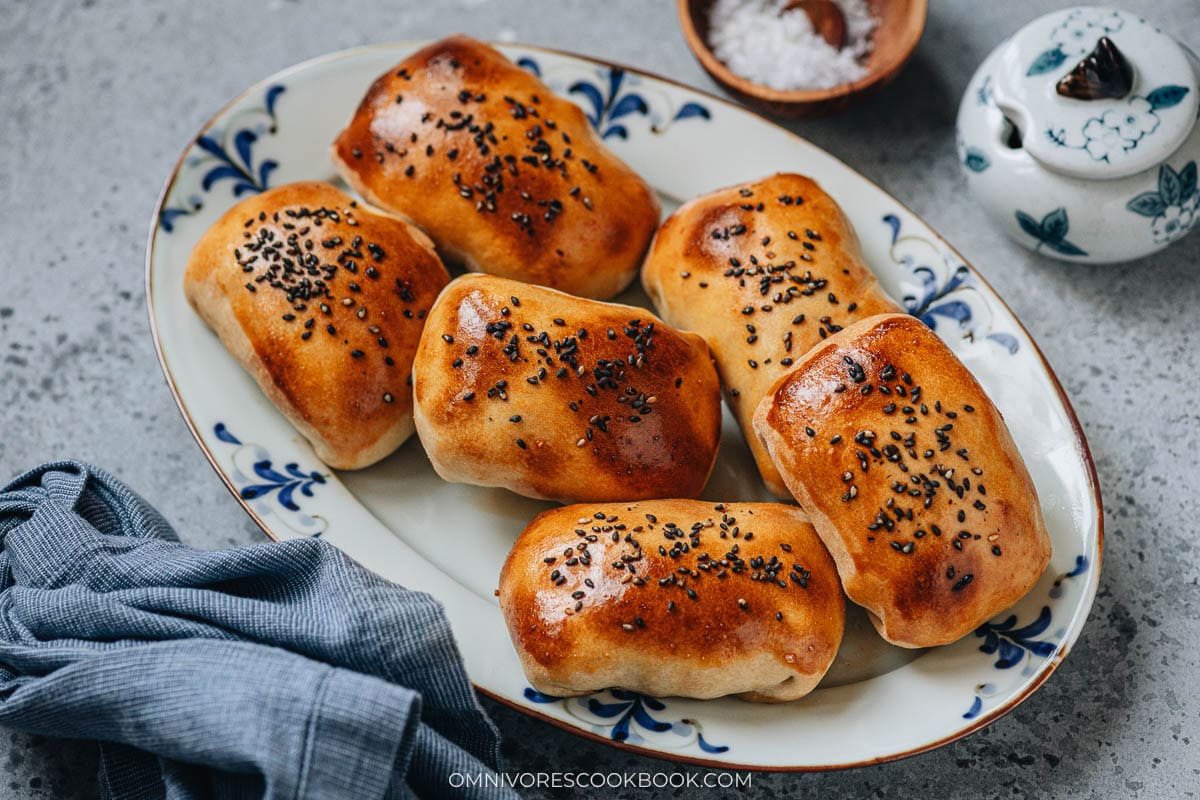
Other Chinese dumplings and buns recipes
- Baked BBQ Pork Buns (Char Siu Bao)
- Sheng Jian Bao (生煎包, Shanghai Pan-Fried Pork Buns)
- Chinese Lamb Dumplings
- Chinese Beef Meat Pie (Xian Bing, 牛肉馅饼)
- Chive Pockets (韭菜盒子, Chinese Chive Dumplings)
Chinese Cooking Made Easy
Are you new to this website? This free email series is a great place to start. I’ll walk you through a few of my most popular recipes and show you how and why they work. You’ll quickly start to cook better Chinese food in your own kitchen.
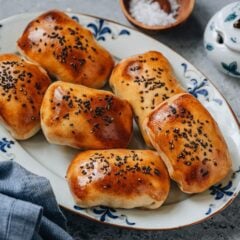
Chinese Baked Buns (烤包子, Kao Bao Zi)
Ingredients
Dough
- 300 g (2 1/2 cups) all-purpose flour , plus extra for dusting
- 1/2 teaspoon salt
- 2 tablespoons vegetable oil
- 1 egg
- 1/2 cup warm water
Filling
- 1 lb lamb leg meat (or ground lamb)
- 1 1/2 teaspoons salt
- 1 tablespoon cumin powder
- 1 1/2 teaspoons ground black pepper
- 2 teaspoons toasted sesame oil
- 1 small onion , minced
Topping
- 1 egg yolk (reserve the egg white)
- 1 teaspoon milk (or water)
- Toasted sesame seeds
Instructions
To make the filling
- Cube lamb meat into 1/4“ (1-cm) pieces and add them into a large bowl. Add salt, cumin powder, black pepper. Mix well. Add onion and peanut oil, and mix again.
To make the dough
- Add flour and salt to a large bowl. Stir to mix well. Add the oil and egg. Use a pair of chopsticks to whisk the flour until the wet ingredients are fully absorbed. Slowly add water onto dried flour and keep stirring, until soft dough flakes form and there’s no dry flour on the bowl. If there’s still too much dry flour left in the bowl, add a bit more water. If the dough flakes are very sticky to the touch, add more flour.
- Dust both hands with dry flour and start gathering the dough flakes, until dough forms. Dust a working surface with flour and transfer the dough onto it. Knead the dough until the surface turns smooth, 5 to 10 minutes. The dough should be soft but should not stick to your hand.
- Transfer the dough to a large bowl. Cover with a damp dish towel or plastic wrap. Allow to rest at room temperature for 15 minutes.
- Knead the dough again until it’s very smooth, 2 to 3 minutes. Let rest for another 30 minutes.
To wrap the meat pies
- Preheat the oven to 450°F (230°C). Line a baking tray with parchment paper.
- Beat 1 egg yolk with the milk to make the egg wash. Reserve the white in another bowl.
- Dust the working surface with flour again and transfer the dough onto it (try not to add too much dry flour as long as the dough doesn’t stick to the surface too much, so it’s easier to seal later). Divide the dough into two even pieces. Roll the dough into a long log. Divide each dough log into 5 equal pieces, so you get a total of 10 dough balls (mine weighs 48g to 50g per dough). Work on one at a time, using plastic wrap to cover the rest to prevent it from drying out.
- Knead a piece of dough a few times to shape a ball. Press it into a round disc. Roll the dough with a rolling pin into a round disc that is slightly thicker in the center and thin on the edges, about 7” (18cm) x5” (13cm) in diameter.
- Pack 4 to 5 tablespoons of filling into the center of the dough disc. Fold the longer edges of the dough and pinch them together. To help with sealing, you can brush some egg white until both short ends of the wrapper. Fold the shorter ends so the dough seals the filling inside. Press gently and place onto the baking sheet. Work on the rest of the dough in the same way.
- Brush each bun with a thin layer of egg wash on top and sprinkle sesame seeds to garnish.
- Bake on the middle rack for 25 minutes, until the surface turns golden brown. Let the buns cool off for 5 to 10 minutes before serving.
Nutrition

Did you make this recipe?
I’d love to hear how it turned out for you! Please take a moment to leave a 5-star rating ⭐️ and share your thoughts in the comments further down the page. It really helps others discover the recipe too.

Liz
These turned out amazing! I opted for ground lamb because it was a bit easier to manage. The recipe was easy to follow and resulted in delicious buns.
Barbara
These look yummy! Could I grind the lamb?
Olav Riise
Wow, this looks so good! One question: do you put the meat raw into the dough? You don’t cook the filling in the pan before you put it in the dough and bake it?
Maggie Zhu
I don’t cook the filling. It should be cooked through in the oven (as long as you don’t wrap super big samosas).
Kalena Likong
Thank you for bringing back my travels on the Silk Road to Xinjiang and eating such great foods like Samsa Kao. Baozi,, Ban mian lagman noodles , Shaozi mian, Kao Rou, Uyghur polo pilaf ne snacking on Matang…. for being from Hawaii and having some Chinese roots from Guandong growing up with Cantonese cuisine or Han cuisine the food on the Silk Road brought an eye opening to the far western food with its Muslim and. Middle eastern an de “Stan” influeces cumin and mutton rule, so different from my pork centric cantonese Siu Yuk and char Siu standards.
Doh Je!
Mahalo
xièxie
Maggie
Thanks for your kind words Kalena! I grew up in Beijing so the xinjiang food is a part of my culture. On the other hand, I was totally surprised the first time when I have Cantonese food and dim sum, and fell in love immediately! Isn’t it so wonderful that China has such diverse cuisines? I’m curious about the food you can get in Hawaii. I’ve heard many good words about it, and I think some of the Hawaiian dishes assemble with Asian dishes that I know. Hopefully I’ll able to travel there in the future 🙂
Kathleen | HapaNom
Oh My GAWD!!!! This looks absolutely delicious! Aren’t foods in pockets just the best!?
Bam’s Kitchen
My boys would love those hearty meat pies. I think I would love the ease of using the wrappers and baking them. Both ideas are great. Sharing of course!
GiGi Eats
A PILLOW FILLED WITH LAMB!! A dream come true right there! ha ah!
Nancy | Plus Ate Six
I like the taste of the original version with the pastry if you were making them for me, but if I was doing them myself, I’d go the easy way! I love the Uyghar combo of lamb and cumin it’s quite addictive.
Melinda @ RecipeFiction
I hardly ever take the short cut in cooking but I appreciate being given permission 😉 These look wonderful. I love cooking with lamb and I love samosas so I definitely need to give these a try!
Judit + Corina @Glamorous Bite
Oh my we love Samosas and these look like little pockets of delight with that savory filling! Hope you are having a lovely Spring!
Prash@YummilyYours
While I don’t eat lamb, I can imagine these amazing samosas with a vegetarian filling 🙂
Maggie
Oh, a vegetarian filling sounds so delicious! The things pumped in my head now are potato and onion. I would like to try them the next time 🙂
Nagi@RecipeTinEats
YES YES YES!! Chinese version of Indian Samosas? This I must must MUST try!! Pinning! Pinning wildly!
Shinee
Maggie, these samosas look so delicious! And they look pretty easy too.
Marissa | Pinch and Swirl
These samosas look so comforting and delicious! I love how many of them you end up with! I love that you can freeze them and bake as needed!